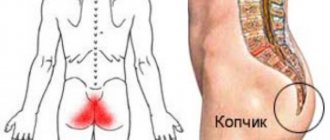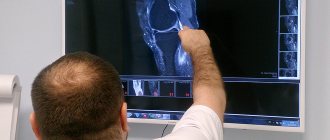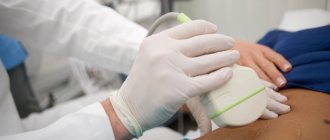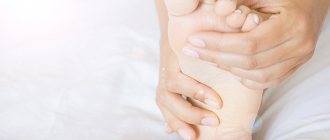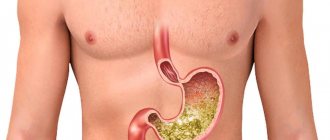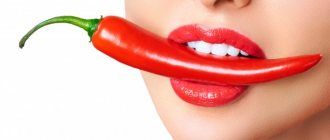- inflammatory (hepatitis)
- sclerotic and degenerative (cirrhosis, fatty hepatosis)
- tumors (primary and metastases)
Stomach diseases:
- gastritis
- peptic ulcer (more often when ulcerative defects are located in the pylorus)
Diseases of the duodenum
- duodenitis
- peptic ulcer
- tumors and blockages of the Vater nipple - the exit point of the common bile duct, which removes bile and pancreatic secretions.
Referring pain in the right hypochondrium may reflect pain from distant organs:
- appendix (inflammation)
- right fallopian tube and ovary in women (inflammation, ectopic pregnancy, tumors)
- large intestine (tumors, ulcerative colitis).
Pain in the left hypochondrium
Usually associated with the following pathologies.
Pancreatic diseases:
- inflammation
- tumors
Spleen diseases:
- blood pathology
- splenic injury
- some infectious diseases
“Referred” pain in the left hypochondrium may be associated with diseases:
- heart (infarction, pericarditis)
- kidneys (usually with kidney stones)
- large intestine (tumors, ulcerative colitis)
- lungs (pleurisy or inflammation).
The localization of pain in the hypochondrium does not always coincide with the location of the diseased organ - the source of pain. Painful sensations in most diseases can spread both to the opposite side and to the entire upper abdomen.
Generalized pain
In this case, the patient complains of discomfort throughout the abdomen. The syndrome can be caused by the following conditions.
- Constipation. The situation is accompanied by bloating, loss of appetite, and sometimes nausea. The solution to the problem is drinking plenty of fluids and eating foods rich in fiber.
- Irritable bowel syndrome. The condition is characterized by colicky pain, accompanied by diarrhea or constipation, and bloating. Therapy is focused on eliminating the causes of the disease and includes diet.
- Back pain can radiate to the abdomen, which indicates disorders in the lumbosacral spine and requires consultation with a neurologist.
Diagnostic stages
1. Consultation with a gastroenterologist, who prescribes an examination plan and consultations with other specialists.
2. Examination of organs located in the upper half of the abdomen and adjacent areas.
- Laboratory tests, including blood tests, examination of secretions (stomach juice, feces, bile, etc.), tests for Helicobacter, etc.
- Endoscopic examination of the stomach, duodenum and other parts of the intestine.
- Echoscopic examinations (ultrasound), including those combined with endoscopic examinations (endo-ultrasound).
- X-ray examination, CT (including virtual colonoscopy) and MRI.
- Special studies aimed at searching for tumor formations, for example, MR diffusion (MRI tumor search).
Diagnosis of possible problems
If we focus on neurological pathologies, the main diagnostic methods are magnetic resonance imaging (MRI) and computed tomography (CT).
We strongly recommend MRI. This is a modern method of detecting problems not only of the spine, but also of the nervous system as a whole. It is absolutely harmless, has virtually no contraindications, and is carried out quickly and easily.
In our clinic you can undergo all the necessary “checking” of the spine for the presence of certain pathologies. Experienced specialists will accurately assess your health condition and, if necessary, prescribe supportive therapy.
For other pathologies, the doctor may also prescribe:
- Ultrasound;
- Lab tests;
- ECG and so on.
Treatment
Getting rid of pain in the hypochondrium is certainly associated with effective treatment of the disease that caused it. The Clinical Hospital on Yauza has all the necessary conditions for quick and accurate differential diagnosis on a single basis of the diagnostic and treatment center, including all the necessary specialists.
Based on an exhaustive diagnosis, our hospital specialists formulate a diagnosis and, taking into account the individual characteristics of each patient, select the optimal treatment path. Both conservative and surgical methods can be used, including minimally invasive organ-preserving techniques that are most suitable for a specific clinical case.
If you experience pain in the hypochondrium, contact the Clinical Hospital on Yauza, where you will be quickly and expertly diagnosed and treated.
You can see prices for services
Why does constipation hurt?
As a result of impaired mobility, feces accumulate inside the intestines, which gradually provokes intoxication. Accumulated feces put pressure on the intestinal walls, causing pain. In addition, with constipation, gas formation increases and the passage of gases is disrupted. This also causes pain and discomfort. In some cases, pain can be felt not only in the lower abdomen, but also on the right, left, as well as in the right hypochondrium and lower back.
Researchers note that the acute pain of constipation is more likely to result from cramping. Thus, Shulpekova draws attention to the fact that stool retention is accompanied by “spastic pain.” (Shulpekova Yu. O., 2007, p. 1165). Indeed, spasms of smooth muscles that occur in response to a mechanical stimulus in the form of dense feces and accumulated gases are felt by us as sharp, cramping pains. The localization of pain can be completely different. It all depends on the specific part of the intestine that is currently affected, as well as upon exposure to other factors previously.
Causes of rib pain
Pain on the left or right under the ribs can have a different nature, as well as the reasons that cause it. It can be strong and almost imperceptible, aching or sharp, occurring at certain moments or continuous. In almost every case, the cause of pain may be a disease that develops in the chest area.
At CELT you can get advice from a specialist algologist.
Make an appointment
Chest injuries
Chest injuries usually include fractures or bruises of the ribs. Fractures are characterized by ruptures of bone tissue and cartilaginous joints of one or more ribs. Depending on the injury, pain symptoms may be constant, aching, or acute and intense.
Bruises are characterized by mild pain, which is accompanied by swelling and the appearance of a hematoma in the area of injury. As a rule, pain symptoms disappear after seven to ten days. Fractures require mandatory diagnosis in order to exclude the possibility of injury to the soft tissues of the lung or other internal organs. Depending on the side of the injury, the pain can be localized on the right or left under the ribs or between them. Its intensity and duration depend on how severe the injury was.
Intercostal neuralgia
Pain between the ribs along the nerves can occur due to the following diseases:
- osteochondrosis of the thoracic spine;
- vertebral protrusion;
- intervertebral hernia.
Attacks in the form of shooting pain, similar to an electric shock, occur due to pinched or irritated nerve roots, and their appearance can be triggered by the following factors:
- hypothermia;
- penetration of infection;
- exercise stress;
- getting a back injury.
The pain becomes stronger with strong inhalations/exhalations or attempts to change body position.
Costochondritis
Costochondritis (or, as it is also called, Tietze's syndrome) is a disease in which thickening of the cartilage tissue of the ribs occurs, leading to their pain. Pain is not localized in one place and can spread to the entire sternum. They can be quite strong and appear brighter with sudden movements, deep inhalations/exhalations or coughing. Pain may be accompanied by:
- local edema;
- an increase in temperature in the area of the pathological process.
It appears suddenly and in its manifestations is comparable to an angina attack.
Angina pectoris
Angina is characterized by constant, pressing pain behind the sternum and sometimes between the ribs. It is localized in the retrosternal region and can spread to the left side of the neck, left arm and left side of the chest and may be accompanied by:
- heart rhythm disturbances;
- feeling of fear.
Other reasons
In addition, pain in the ribs can occur with the following diseases:
- malignant neoplasms (in particular, osteosarcoma of the ribs) are characterized by dull pain at the beginning of the disease, which becomes more and more pronounced as it develops;
- fibromyalgia - pain occurs when trying to raise your arms or turn your torso;
- pleurisy - pain symptoms manifest themselves with coughing and deep inhalations/exhalations;
- herpes zoster - characterized by intense pain under the ribs in the right or left side, which is accompanied by itching or burning.
Another reason is hypertonicity of the pectoral muscles, which occurs as a result of intense physical activity. The pain in this case increases and is localized in the intercostal space.
More about fibromyalgia
Possible complications of constipation
Frequent constipation may be accompanied by heaviness in the abdomen and pain before, during or after bowel movements. Such problems can lead to unpleasant consequences. Most common complications:+
- poisoning of the body;
- exacerbation of hemorrhoids;
- rectal fissures;
- risk of cancer.
General intoxication due to stagnant feces can cause deterioration in health and decreased performance. Disruption of the intestinal microbial balance during chronic constipation leads to exacerbation of allergic diseases, skin rashes, and a decrease in the body's resistance to infections.
It is known that the risk of developing colorectal cancer is higher in people with chronic constipation. Delayed bowel movements lead to disruption of cholesterol metabolism and the development of atherosclerosis, and consequently, cardiovascular diseases.
Diseases of the anorectal area often accompany constipation. This is due to the fact that dense feces injure the mucous membranes of the rectum, which causes the appearance of anal fissures. And an increase in intra-abdominal pressure can lead to the formation of hemorrhoids.
Treatment of pain due to constipation
In the fight against pain due to constipation, the following will help:
- Nutrition aimed at increasing the amount of fiber consumed. Diet is the main method of treating functional constipation caused by decreased intestinal motility.
- Lifestyle changes. Involves increased physical activity and regular physical activity.
- Discontinuation of medications that cause constipation.
It is important to understand that you should not stop taking medications prescribed by your doctor on your own. For example, if you are taking iron supplements that are causing you to have bowel movements, changing the dosage yourself or stopping it may make your iron deficiency anemia worse. Contact your doctor for advice on alternative medications or dosage adjustments. Particular caution should be exercised when taking hormonal drugs, antidepressants, anticonvulsants, and narcotic analgesics.
The main condition for getting rid of abdominal pain due to constipation is the normalization of stool. Symptomatic treatment in the form of painkillers and antispasmodics will not give long-term results. In addition, it is worth remembering that in some cases, constipation is associated with a weakening of intestinal motility - a change in the tone of its muscles. In this case, anti-spasm medications may aggravate the underlying problem.
Foods high in fiber will help normalize stool. These include bran, white cabbage (fresh and pickled), celery and other vegetables. Whole grains such as bulgur and buckwheat, as well as nuts, are rich in dietary fiber.
At the same time, it is better to avoid products that have a fixing effect. These include foods high in tannin: chocolate, black tea, red wine, white rice, etc. You should avoid baked goods, sweets, bread and pastries with cream - they increase gas formation and also provoke fermentation in the intestines.
You need to eat in small portions, but often. Small meals 5-6 times a day will ensure a uniform supply of nutrients to the body and will help avoid stretching the walls of the stomach and intestines.
Medication should not be aimed at eliminating pain, but at its cause. Pain usually goes away with bowel movements, so it is important to choose the appropriate way to quickly get rid of the problem. Laxatives will help cope with this. They come in several types:
- Osmotic, or saline, increases the volume of fluid in the intestines.
- Stimulating - act irritatingly on intestinal receptors, stimulating peristalsis.
- Volumetric - increase the volume of stool and change its consistency.
- Auxiliary - mechanically help promote the movement of feces in the intestines (for example, oil).
There are also local drugs that act as an irritant on the mucous membranes of the rectum and soften the passage of feces. The use of cleansing enemas may also be advisable, but often resorting to them is not recommended due to possible disturbances of the local microflora.

